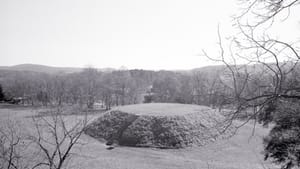Stay in the Loop
BSR publishes on a weekly schedule, with an email newsletter every Wednesday and Thursday morning. There’s no paywall, and subscribing is always free.
America's earthen pyramids
Penn Museum presents 'Moundbuilders: Ancient Architects of North America'

Most of us have heard of Stonehenge and the Pyramids. Far fewer of us know that more than 5,500 years ago, Native peoples built monuments right here in the United States. Moundbuilders: Ancient Architects of North America, at Penn Museum, examines those massive earthworks — tens of thousands of “mounds” — their purposes, their builders, their significance for Native Americans, and how they are studied. The exhibition will have you looking twice at every hill on the horizon.
Older than the pyramids
The oldest-known mounds, at Louisiana’s Watson Brake complex, date to about 3500 BCE, a thousand years earlier than the Great Pyramid at Giza. Watson Brake consists of 11 mounds around an open space, connected by a 900-foot-long raised causeway.
Archaeologists believe mound uses varied. Some were burial grounds, others ceremonial spaces, and, perhaps most significantly, says Megan C. Kassabaum, assistant curator for North America at Penn Museum, moundbuilding forged common ties among disparate groups. “They created a sense of community among peoples, just as a barn raising did centuries later.”
A massive undertaking
Evidence reveals mounds were built by transporting loosened dirt in baskets. At northeastern Louisiana’s Poverty Point, the largest mound measures 710 feet long by 600 feet wide by 70 feet high, which required moving 15.5 million baskets of dirt.
Though archaeologists have theories about mound uses, they’re not sure what prompted so many groups to build them across the centuries. “I expect to spend the rest of my career on this,” says Kassabaum, who directs Penn’s archaeological fieldwork at the Smith Creek mound site in Mississippi.
She discovered her profession as a child, digging in the backyard of her home near Saint Louis and visiting Illinois’s Cahokia Mounds, the largest prehistoric settlement of people and monumental architecture north of Mexico. From about 1000 to 1500 CE, Cahokia was home to 20,000 people and consisted of hundreds of mounds. Many now lie beneath Saint Louis and East Saint Louis.

Sacred spaces still
In curating the exhibition, Kassabaum puts visitors into archaeologists’ boots, displaying artifacts that demonstrate how she and her colleagues extrapolate the past from what’s visible in the present. Much of Moundbuilders focuses on Smith Creek, constructed by the Coles Creek Culture, which inhabited the region between 700 and 1200 CE.
Photographs by Jenny Ellerbe and Tom Patton effectively depict the way mounds hide in plain sight: present when you know what to look for, blending into the landscape when you don’t.
Videos show the dig site and what happens to artifacts in the lab, as well as commentary by the Eastern Band of the Cherokee on the significance of North Carolina’s Kituwah Mound. The Cherokee believe their people were born at Kituwah and gather annually for a moundbuilding ceremony. In the 19th century, the Cherokee were forcibly relocated from here to Oklahoma along the Trail of Tears. A tribal prophecy says they were destined to lose the site and reclaim it. And so they have.
“I wanted to emphasize that these places are tied to contemporary communities,” says Kassabaum. “They are actively utilizing ancient mounds today.”
Some still undiscovered
Mounds are commonly found in river valleys because, Kassabaum explains, rivers provide ample food and therefore time for other pursuits. Tens of thousands of mounds are thought to have once dotted the Mississippi valley.
As at Cahokia, the building of cities, highways, and farming leveled mounds over great swaths of land. Kassabaum says that because of centuries of farming, mounds are not found along the East Coast. The mounds nearest Philadelphia are Irvine Flats, in northwestern Pennsylvania’s Buckaloons Recreation Area of the Allegheny National Forest, and Fernleigh Mound, in Cooperstown, New York.

Though many have disappeared, there are still mounds to be found, especially in settled areas that tolerate irregular terrain. “Golf courses and cemeteries are good places,” Kassabaum recommends. But don’t bother looking further west than Texas. Evidently, ancients beyond the Mississippi engaged in activities better suited to those environments, such as carving cliff dwellings in the Southwest and creating totem poles in the timber-rich Northwest.
When is a hill a mound?
So when is a big hill really an ancient mound? To know, you have to dig. A mound core sample has a specific signature: two stripes of dark topsoil separated by lighter dirt, which indicates that earth was piled atop an existing surface. Whether it’s prehistoric depends on the artifacts. For an archaeologist, broken is better.
“Broken things show daily life,” Kassabaum says. “If I went into your house and you weren’t there, I could see things you left out. But if I really wanted to know how you lived, I’d go through your garbage.” For example, if a curved pottery fragment can be read as coming from a large platter, it says the location was ceremonial — many were fed; food was served, but not necessarily cooked, on site. Also, an archaeologist can date pottery by its edging as efficiently as a fashionista can tell a blouse’s era by its trim.
Moundbuilders uncovers the largely unknown phenomenon of monumental building right in our own backyard. For thousands of years, these mysterious structures transformed the landscape and those who built them.
What, When, Where
Moundbuilders: Ancient Architects of North America. Through December 2019, at the Penn Museum, 3260 South Street, Philadelphia. (215) 898-4000 or penn.museum.
Sign up for our newsletter
All of the week's new articles, all in one place. Sign up for the free weekly BSR newsletters, and don't miss a conversation.
